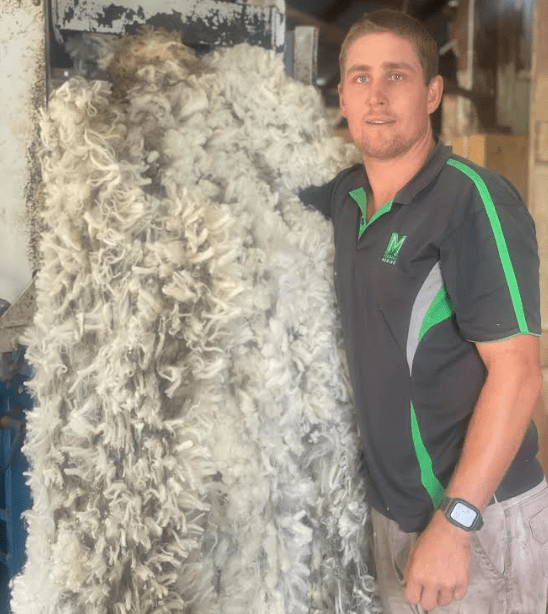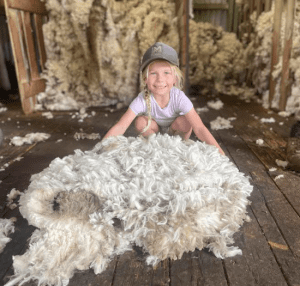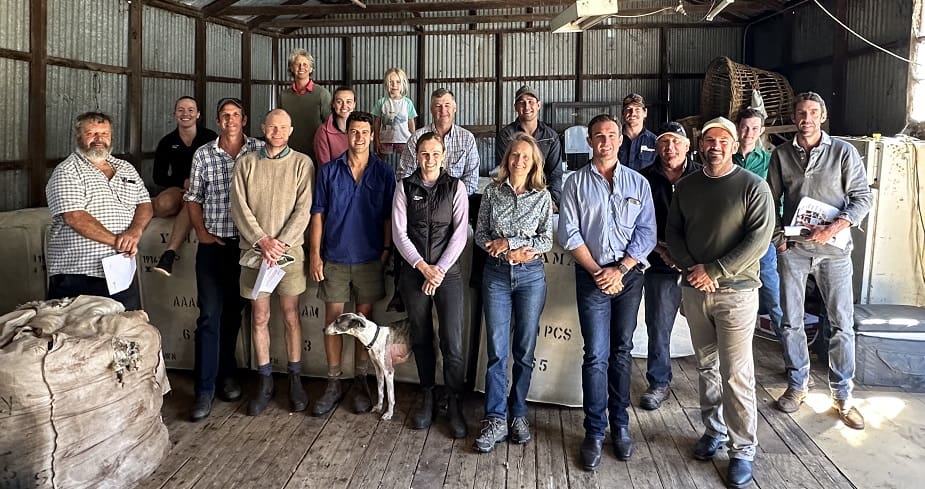
Rick Luhrs is filling bales with wool for consumers wanting garments from regenerative farming.
VICTORIAN Merino breeder Rick Luhrs is among a select group of Australian growers assessing the ecological outcomes of their farm management through soil analysis.
The Luhrs family operation, Mooralla Merino, is one of eight Australian flocks participating in an ecological outcome verification (EOV) pilot through the The New Zealand Merino Company’s regenerative wool-sourcing program, ZQRX.
Rick said the EOV program and ZQRX fit with his and his father Russell ideas of holistic farm management, encompassing the land, animals, plants and people.
“That’s the exciting bit, it’s not just looking at the product, it’s looking at the whole gambit.”
Mooralla is midway between Hamilton and Horsham east of the Grampians or Gariwerd range where the Luhrs family run a flock of 5000 Merino ewes, including their own stud that is based on Trigger Vale blood, with infusions of Anderson, Mumblebone and Wallaloo Park.
Australian Holistic Management Co-operative has conducted EOV monitoring to baseline the eight ZQRX farms, spread around Victoria, New South Wales, Tasmania and South Australia. The growers in the group run between 5000-25,000 ewes.
As well as the EOV monitoring, growers were invited to join in holistic management training to help aid their understanding of ways to improve soil health and function, leading to regenerating outcomes and further opportunities for improvement. The first stage of the pilot culminated with an in-depth soil health workshop at Mooralla Merinos in Victoria.

Nellie Luhrs, 4, enjoys getting into some wool.
“It’s bloody exciting, it’s a whole different way of doing it – the gist of it is NZ Merino is selling the story and they need the numbers to match the story.”
He said the pilot will involve EOV monitoring six monthly and annually depending on the site, to verify that NZM growers are improving the land, pastures and soil.
Mooralla Merinos has been with NZM since 2017 and Rick said strategically contracting part of the clip each year to NZM gave cash flow security, but it also meant he could focus on meeting wool quality specifications.
“You’ve just got to get it right and then you know the product has got a home – that’s exciting for us.”
AHMC chief executive officer, Helen Lewis, said that NZM’s investment in EOV monitoring is an exciting step for its Australian growers.
“It’s a tall order to make improvements without knowing where you are at.
“EOV allows a farmer to quantify the state of play and gives them the confidence to invest their efforts where they are needed,” he said.
“This group is special, the properties cover a diverse range of geographies, each with its own strengths and challenges, but they’re all committed to the common goal of regenerating land.”
The EOV assessment includes both short and long-term monitoring. Short-term sites are revisited annually. Long-term monitoring sites are revisited every five years to capture data on lagging indicators of soil health. EOV reports indicate an Ecological Health Index (EHI). If a grower receives an improving EHI, this indicates that the land is regenerating.
NZM said it is bringing together forward-thinking growers and the globally leading brands that value their wool. Its ZQRX programme was designed to acknowledge the work farmers do beyond what is needed for certification.

NZM and EOV pilot growers and organisers came together for a group shot in the Mooralla wool shed.
NZM’s future farming manager, Monica Schwass, said robust and globally recognised monitoring, such as EOV, provides the verified data leading brands need in the consumer market.
“Our global brand partners want to see regeneration.
“They want to know the wool they buy is doing good things for the world – not simply doing less harm,” she said.
“Most importantly, they want to be able to proudly share this with their customers and they’re willing to invest in reportable data.
“NZM’s EOV journey started with a similar pilot in New Zealand, six farms were baselined in 2020 and all of them have shown positively trending EHI scores,” Monica said.
“Off the back of that, one of our brand partners has invested in management training and monitoring for 30 more properties.”
NZM said repeat EOV monitoring gives them proof that their efforts are working and confidence that their properties will be sustainable, environmentally and financially, for years to come.
NZM growers at Ratharney in Tasmania, Chris and Claire Headlam said the pilot has helped them refine their big-picture goal to improve the landscape over time.
“We just spent a couple of days with a great group of like-minded growers in this program.
“It was awesome for networking, talking about things that have worked – just to see the things people are doing and what’s succeeding,” Chris said.
“It’s more of a holistic goal, things pop up day-to-day, decisions you have to make, but with a goal in mind, things become a lot simpler.
“You don’t get distracted by the noise,” he said.
“When it comes down to it Chris and I agree that we want to see abundance on our farm, we want to see life,” Claire said.

HAVE YOUR SAY